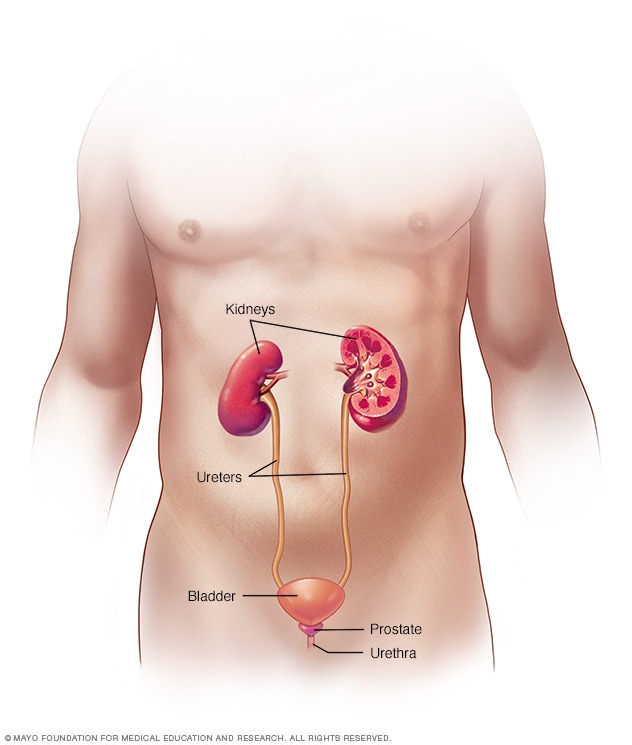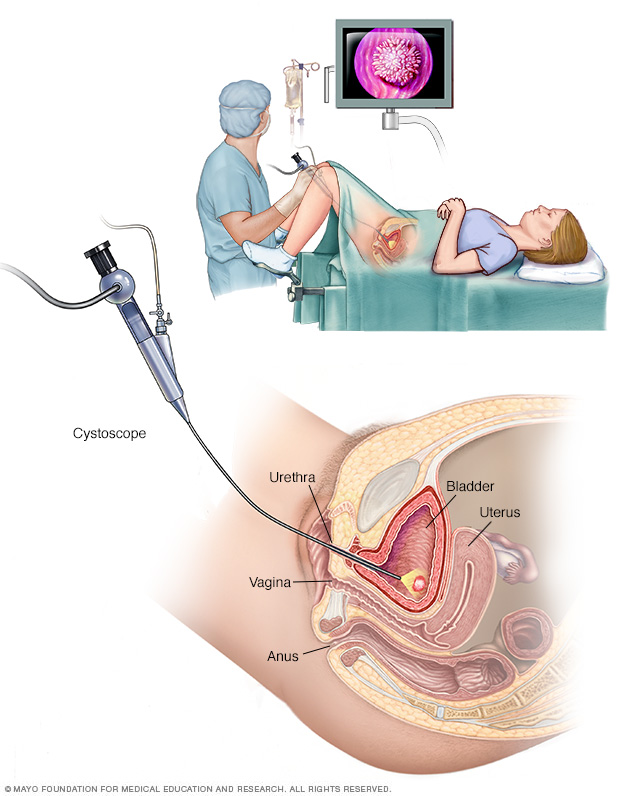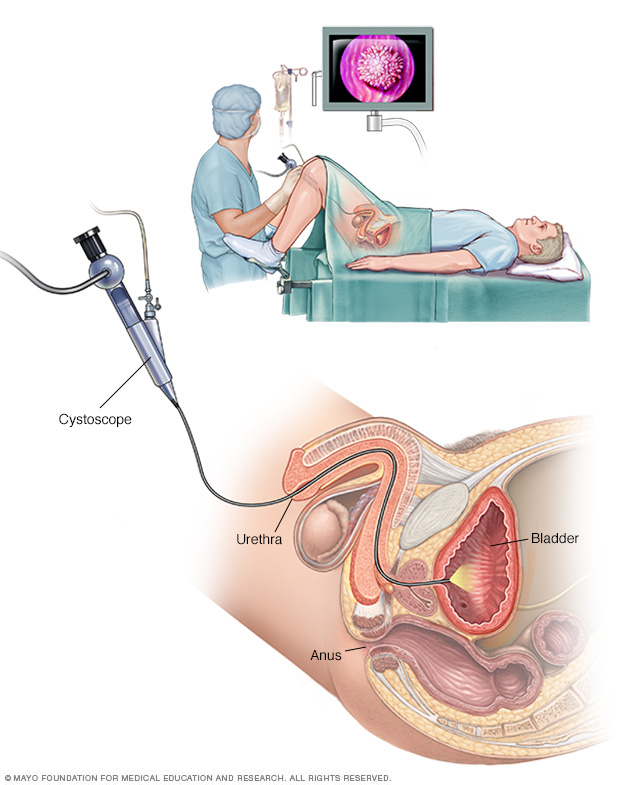Blood in urine (hematuria)
![]() May, 15th, 2024
May, 15th, 2024
Benefit Summary
Lots of things can cause bloody urine. Some are serious problems, and others are harmless. Find out why it’s always important to get a checkup.
Overview
, Overview, ,
It can be scary to see blood in urine, also called hematuria. In many cases, the cause is harmless. But blood in urine also can be a sign of a serious illness.
If you can see the blood, it’s called gross hematuria. Blood that can’t be seen with the naked eye is called microscopic hematuria. It’s such a small amount that it can be seen only under a microscope when a lab tests the urine. Either way, it’s important to figure out the reason for the bleeding.
Treatment depends on the cause.
Symptoms
Blood in the urine can look pink, red or cola-colored. Red blood cells cause the urine to change color. It takes only a small amount of blood to turn urine red.
The bleeding often isn’t painful. But if blood clots get passed in the urine, that can hurt.
When to see a doctor
See a health care provider whenever urine looks like it might have blood in it.
Red urine isn’t always caused by red blood cells. Some medicines can cause urine to turn red, such as a medicine called phenazopyridine that eases urinary tract symptoms. Certain foods also can turn urine red, including beets and rhubarb.
It can be hard to tell whether a change of urine color is caused by blood. That’s why it’s always best to get a checkup.
Causes
This condition happens when the kidneys or other parts of the urinary tract let blood cells leak into urine. Different problems can cause this leaking to happen, including:
- Urinary tract infections (UTIs). These happen when bacteria get into the tube through which urine leaves the body, called the urethra. Then the bacteria multiply in the bladder. UTIs can cause bleeding that makes urine look red, pink or brown. With a UTI, you also may have a strong urge to pee that lasts a long time. You may have pain and burning while peeing. Your urine may have a very strong smell too.
- Kidney infection. This type of UTI also is called pyelonephritis. Kidney infections can happen when bacteria enter the kidneys from the bloodstream. Infections also can happen when bacteria move to the kidneys from a pair of tubes that connect the kidneys with the bladder, called the ureters. Kidney infections can cause the same urine-related symptoms that other UTIs can. But they’re more likely to cause a fever and pain in the back, side or groin.
-
A bladder or kidney stone. The minerals in urine can form crystals on the walls of the kidneys or bladder. Over time, the crystals can become small, hard stones.
The stones are often painless. But they can hurt a lot if they cause a blockage or leave the body through urine. Bladder or kidney stones can cause blood in urine that can be seen with the naked eye as well as bleeding that can be seen only in the lab.
- Enlarged prostate. The prostate gland is just below the bladder, and it surrounds the top part of the urethra. It often gets bigger toward middle age. It then puts pressure on the urethra, partly blocking the flow of urine. With an enlarged prostate, you might have trouble peeing, an urgent or lasting need to pee, or blood in the urine. Infection of the prostate, called prostatitis, can cause the same symptoms.
-
Kidney disease. Blood in urine that can be seen only in the lab is a common symptom of a kidney disease called glomerulonephritis. With this disease, the tiny filters in the kidneys that remove waste from blood become inflamed.
Glomerulonephritis may be part of a condition that affects the whole body, such as diabetes. Or it can happen on its own.
- Cancer. Blood in urine that can be seen with the naked eye may be a sign of advanced kidney, bladder or prostate cancer. These cancers might not cause symptoms sooner, when treatments could work better.
- Inherited illnesses. A genetic condition that affects red blood cells, called sickle cell anemia, can cause blood in urine. The blood cells could be visible or too tiny to see. A condition that damages tiny blood vessels in the kidneys, called Alport syndrome, also can cause blood in the urine.
- Kidney injury. A blow or other injury to the kidneys from an accident or contact sports can cause blood to show up in urine.
- Medicines. The anti-cancer drug cyclophosphamide (Cytoxan) and the antibiotic penicillin are linked to blood in urine. Medicines that prevent blood clots also are tied to blood in urine. These include medicines that keep blood cells called platelets from sticking together, such as the pain reliever aspirin. Medicines that thin the blood, such as heparin, also may be a cause.
-
Hard exercise. Blood in the urine can happen after playing contact sports, such as football. It may be linked to bladder damage caused by getting hit. Blood in urine also can happen with long-distance sports, such as marathon running, but it’s less clear why. It may be linked to bladder damage or other reasons that don’t involve an injury. When hard exercise causes blood in urine, it may go away on its own within a week.
If you see blood in your urine after exercise, don’t assume it’s from exercising. See your health care provider.
Often the cause of hematuria is unknown.

Your urinary system includes the kidneys, ureters, bladder and urethra. The urinary system removes waste from the body through urine. The kidneys are located toward the back of the upper abdomen. They filter waste and fluid from the blood and produce urine. Urine moves from the kidneys through narrow tubes to the bladder. These tubes are called the ureters. The bladder stores urine until it’s time to urinate. Urine leaves the body through another small tube called the urethra.

Your urinary system includes the kidneys, ureters, bladder and urethra. The urinary system removes waste from the body through urine. The kidneys are located toward the back of the upper abdomen. They filter waste and fluid from the blood and produce urine. Urine moves from the kidneys through narrow tubes to the bladder. These tubes are called the ureters. The bladder stores urine until it’s time to urinate. Urine leaves the body through another small tube called the urethra.
Male urinary system Risk factors
Almost anyone can have red blood cells in the urine. This includes children and teens. Some things that can raise the risk of blood in the urine include:
- Age. Middle-aged and older men may be more likely to have hematuria due to an enlarged prostate gland. The risk of some cancers that can cause blood in urine also may rise after the age of 50.
- Urinary tract infection. This is one of the top causes of blood that can be seen in children’s urine.
- Family history. The chances of having blood in the urine may go up if one or more family members have had kidney disease.
- Certain medicines. Some pain relievers, blood thinners and antibiotics can raise the risk of blood in urine.
- Hard exercise. Marathon runner’s hematuria is one nickname for hematuria. Contact sports can raise the risk too.
Diagnosis
These tests and exams play a key role in finding a cause for blood in the urine:
- Physical exam. This includes a talk with a health care provider about your health history.
- Urine tests. These can be used to diagnose blood in the urine. They also can be used weeks or months later to see if the urine still has blood in it. Urine tests also can check for a urinary tract infection or for minerals that cause kidney stones.
- Imaging tests. An imaging test is often needed to find the cause of blood in the urine. You might need a CT or MRI scan, or an ultrasound exam.
- Cystoscopy. A health care provider threads a narrow tube fitted with a tiny camera into your bladder to check for signs of disease.
Sometimes the cause of blood in the urine can’t be found. In that case, you might need regular follow-up tests, mainly if you have risk factors for bladder cancer. These risk factors include smoking, radiation therapy to the pelvis or exposure to certain chemicals.

Cystoscopy allows a health care provider to view the lower urinary tract to look for problems, such as a bladder stone. Surgical tools can be passed through the cystoscope to treat certain urinary tract conditions.

Cystoscopy allows a health care provider to view the lower urinary tract to look for problems, such as a bladder stone. Surgical tools can be passed through the cystoscope to treat certain urinary tract conditions.

Cystoscopy allows a health care provider to view the lower urinary tract to look for problems in the urethra and bladder. Surgical tools can be passed through the cystoscope to treat certain urinary tract conditions.

Cystoscopy allows a health care provider to view the lower urinary tract to look for problems in the urethra and bladder. Surgical tools can be passed through the cystoscope to treat certain urinary tract conditions.
Male cystoscopy Treatment
The treatment for blood in the urine depends on the cause. Treatment might involve:
- Taking antibiotic medicines to clear a urinary tract infection.
- Trying a prescription medicine to shrink an enlarged prostate.
- Having a treatment that uses sound waves to break up bladder or kidney stones.
In some cases, no treatment is needed.
If you get treatment, see your provider afterward to make sure there’s no more blood in your urine.
Preparing for an appointment
You can start by making an appointment with your regular health care provider. Or you might be referred to a doctor who specializes in urinary tract disorders, called a urologist.
Here’s some information to help you prepare for your appointment.
What you can do
Make a list of:
- Your symptoms. Include any symptoms, even ones that may not seem to be related to the reason for your checkup. Note when your symptoms began too.
- Key medical information. This includes other conditions for which you’re being treated. Note whether bladder or kidney diseases run in your family too.
- All medicines, vitamins or other supplements you take. Include the doses for each. The dose is how much you take.
- Questions to ask your health care provider.
Some questions to ask about blood in the urine include:
- What might be causing my symptoms?
- What tests do I need?
- How long might this condition last?
- What are my treatment choices?
- I have other health issues. How can I best manage them together?
- Are there brochures or other printed material that I can have? What websites do you suggest?
Ask any other questions too.
What to expect from your doctor
Your provider is likely to ask you questions, such as:
- Do you have pain when you pee?
- Do you see blood in your urine only sometimes or all the time?
- When do you see blood in your urine — when you start peeing, toward the end of your urine stream or the entire time you’re peeing?
- Are you also passing blood clots when you pee? What size and shape are they?
- Do you smoke?
- Are you exposed to chemicals on the job? What kinds?
- Have you had radiation therapy?


